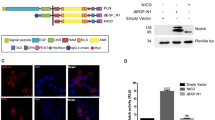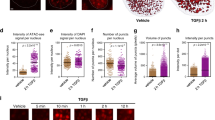Abstract
Crosstalk between signaling pathways is crucial for the generation of complex and varied transcriptional networks. Antagonism between the EGF-receptor (EGFR) and Notch pathways in particular is well documented, although the underlying mechanism is poorly understood. The global corepressor Groucho (Gro) and its transducin-like Enhancer-of-split (TLE) mammalian homologs mediate repression by a myriad of repressors, including effectors of the Notch, Wnt (Wg) and TGF-β (Dpp) signaling cascades1,2,3,4,5,6,7,8. Given that there are genetic interactions between gro and components of the EGFR pathway9 (ref. 9 and P.H. et al., unpublished results), we tested whether Gro is at a crossroad between this and other pathways. Here we show that phosphorylation of Gro in response to MAPK activation weakens its repressor capacity, attenuating Gro-dependent transcriptional silencing by the Enhancer-of-split proteins, effectors of the Notch cascade. Thus, Gro is a new junction between signaling pathways, enabling EGFR signaling to antagonize transcriptional output by Notch and potentially other Gro-dependent pathways.
This is a preview of subscription content, access via your institution
Access options
Subscribe to this journal
Receive 12 print issues and online access
$209.00 per year
only $17.42 per issue
Buy this article
- Purchase on Springer Link
- Instant access to full article PDF
Prices may be subject to local taxes which are calculated during checkout






Similar content being viewed by others
References
Paroush, Z. et al. Groucho is required for Drosophila neurogenesis, segmentation, and sex determination and interacts directly with hairy-related bHLH proteins. Cell 79, 805–815 (1994).
Giagtzoglou, N., Alifragis, P., Koumbanakis, K.A. & Delidakis, C. Two modes of recruitment of E(spl) repressors onto target genes. Development 130, 259–270 (2003).
Cavallo, R.A. et al. Drosophila Tcf and Groucho interact to repress Wingless signalling activity. Nature 395, 604–608 (1998).
Roose, J. et al. The Xenopus Wnt effector XTcf-3 interacts with Groucho-related transcriptional repressors. Nature 395, 608–612 (1998).
Hasson, P., Muller, B., Basler, K. & Paroush, Z. Brinker requires two corepressors for maximal and versatile repression in Dpp signalling. EMBO J. 20, 5725–5736 (2001).
Zhang, H., Levine, M. & Ashe, H. Brinker is a sequence-specific transcriptional repressor in the Drosophila embryo. Genes Dev. 15, 261–266 (2001).
Chen, G. & Courey, A.J. Groucho/TLE family proteins and transcriptional repression. Gene 249, 1–16 (2000).
Levanon, D. et al. Transcriptional repression by AML1 and LEF-1 is mediated by the TLE/Groucho corepressors. Proc. Natl. Acad. Sci. USA 95, 11590–11595 (1998).
Price, J.V., Savenye, E.D., Lum, D. & Breitkreutz, A. Dominant enhancers of Egfr in Drosophila melanogaster: genetic links between the Notch and Egfr signaling pathways. Genetics 147, 1139–1153 (1997).
Queenan, A.M., Ghabrial, A. & Schupbach, T. Ectopic activation of torpedo/Egfr, a Drosophila receptor tyrosine kinase, dorsalizes both the eggshell and the embryo. Development 124, 3871–3880 (1997).
Brunner, D. et al. A gain-of-function mutation in Drosophila MAP kinase activates multiple receptor tyrosine kinase signaling pathways. Cell 76, 875–888 (1994).
Zecca, M., Basler, K. & Struhl, G. Direct and long-range action of a wingless morphogen gradient. Cell 87, 833–844 (1996).
Schweitzer, R., Shaharabany, M., Seger, R. & Shilo, B.Z. Secreted Spitz triggers the DER signaling pathway and is a limiting component in embryonic ventral ectoderm determination. Genes Dev. 9, 1518–1529 (1995).
Zecca, M. & Struhl, G. Subdivision of the Drosophila wing imaginal disc by EGFR-mediated signaling. Development 129, 1357–1368 (2002).
Wessells, R.J., Grumbling, G., Donaldson, T., Wang, S.H. & Simcox, A. Tissue-specific regulation of vein/EGF receptor signaling in Drosophila. Dev. Biol. 216, 243–259 (1999).
Wang, S.H., Simcox, A. & Campbell, G. Dual role for Drosophila epidermal growth factor receptor signaling in early wing disc development. Genes Dev. 14, 2271–2276 (2000).
de Celis, J.F. & Bray, S. Garcia-Bellido, A. Notch signalling regulates veinlet expression and establishes boundaries between veins and interveins in the Drosophila wing. Development 124, 1919–1928 (1997).
zur Lage, P. & Jarman, A.P. Antagonism of EGFR and notch signalling in the reiterative recruitment of Drosophila adult chordotonal sense organ precursors. Development 126, 3149–3157 (1999).
Culi, J., Martin-Blanco, E. & Modolell, J. The EGF receptor and N signalling pathways act antagonistically in Drosophila mesothorax bristle patterning. Development 128, 299–308 (2001).
Shaye, D.D. & Greenwald, I. Endocytosis-mediated downregulation of LIN-12/Notch upon Ras activation in Caenorhabditis elegans. Nature 420, 686–690 (2002).
de Celis, J.F. & Ruiz Gomez, M. groucho and hedgehog regulate engrailed expression in the anterior compartment of the Drosophila wing. Development 121, 3467–3476 (1995).
Rohrbaugh, M. et al. Notch activation of yan expression is antagonized by RTK/pointed signaling in the Drosophila eye. Curr. Biol. 12, 576–581 (2002).
Nuthall, H.N., Joachim, K., Palaparti, A. & Stifani, S. A role for cell cycle-regulated phosphorylation in Groucho-mediated transcriptional repression. J. Biol. Chem. 277, 51049–51057 (2002).
Parkhurst, S.M. Groucho: making its Marx as a transcriptional co-repressor. Trends Genet. 14, 130–132 (1998).
Simon, M.A. Receptor tyrosine kinases: specific outcomes from general signals. Cell 103, 13–15 (2000).
Zhang, H. & Levine, M. Groucho and dCtBP mediate separate pathways of transcriptional repression in the Drosophila embryo. Proc. Natl. Acad. Sci. USA 96, 535–540 (1999).
Courey, A.J. & Jia, S. Transcriptional repression: the long and the short of it. Genes Dev. 15, 2786–2796 (2001).
Bianchi-Frias, D. et al. Hairy transcriptional repression targets and cofactor recruitment in Drosophila. PLoS Biol. 2, E178 (2004).
Barolo, S., Stone, T., Bang, A.G. & Posakony, J.W. Default repression and Notch signaling: Hairless acts as an adaptor to recruit the corepressors Groucho and dCtBP to Suppressor of Hairless. Genes Dev. 16, 1964–1976 (2002).
Simpson, P. Notch signalling in development: on equivalence groups and asymmetric developmental potential. Curr. Opin. Genet. Dev. 7, 537–542 (1997).
Acknowledgements
We thank K. Basler, H. Bellen, S. Bray, S. Cohen, C. Delidakis, O. Gerlitz, E. Hafen, Y. Hiromi, F. Laski, E. Martin-Blanco, J. Modolell, D. Montell, G. Morata, A. Salzberg, T. Schupbach, B. Shilo, G. Struhl, the Bloomington Stock Centre and the Developmental Studies Hybridoma Bank for fly stocks, reagents and antibodies; S. Katzav, C. Levy and R. Grossman for technical assistance; and Y. Bergman, D. Ish-Horowicz, G. Jiménez, B. Shilo and J. Yisraeli for comments on the manuscript. This work was supported by grants from the Israel Science Foundation, Israel Cancer Research Fund, Lejwa Fund for Biochemistry and the Król Charitable Foundation to Z.P., and by a grant from the US National Institutes of Health to A.J.C. P.H. acknowledges a Clore Foundation PhD Scholarship, and C.W. acknowledges a USPHS National Research Service Training Award. Z.P. is a Braun Lecturer.
Author information
Authors and Affiliations
Corresponding author
Ethics declarations
Competing interests
The authors declare no competing financial interests.
Supplementary information
Supplementary Fig. 1
Differential repression of Spalt expression brought about by distinct Groucho derivatives. (PDF 37 kb)
Supplementary Fig. 2
Activated MAPK attenuates Groucho-mediated repression of a Dorsal responsive reporter in Drosophila S2 cells. (PDF 99 kb)
Supplementary Fig. 3
Groucho levels are unaffected by alterations in MAPK activity levels. (PDF 98 kb)
Supplementary Fig. 4
Groucho is an anti-vein determinant. (PDF 73 kb)
Rights and permissions
About this article
Cite this article
Hasson, P., Egoz, N., Winkler, C. et al. EGFR signaling attenuates Groucho-dependent repression to antagonize Notch transcriptional output. Nat Genet 37, 101–105 (2005). https://doi.org/10.1038/ng1486
Received:
Accepted:
Published:
Issue Date:
DOI: https://doi.org/10.1038/ng1486
This article is cited by
-
The Notch repressor complex in Drosophila: in vivo analysis of Hairless mutants using overexpression experiments
Development Genes and Evolution (2019)
-
Ras–Erk signaling induces phosphorylation of human TLE1 and downregulates its repressor function
Oncogene (2017)
-
BHX Inhibits the Wnt Signaling Pathway by Suppressing β-catenin Transcription in the Nucleus
Scientific Reports (2016)
-
The T-box transcription factor Midline regulates wing development by repressing wingless and hedgehog in Drosophila
Scientific Reports (2016)
-
RETRACTED ARTICLE: TLE3 represses colorectal cancer proliferation by inhibiting MAPK and AKT signaling pathways
Journal of Experimental & Clinical Cancer Research (2016)



